Red mushrooms are a type of fungi that is often found in wooded areas. They have a distinct red coloration and are typically small in size. While they are not the most popular type of mushroom, it’s important for beginner foragers to identify them.
Below is a comprehensive list of red colored wild mushrooms and how to identify them. Read on and learn more.
List of Red Mushrooms
It is important to be cautious when identifying and consuming wild mushrooms, as some species can be poisonous. If you are unsure whether a mushroom is safe to eat, it is best to err on the side of caution and not consume it.
1. Red Waxcap
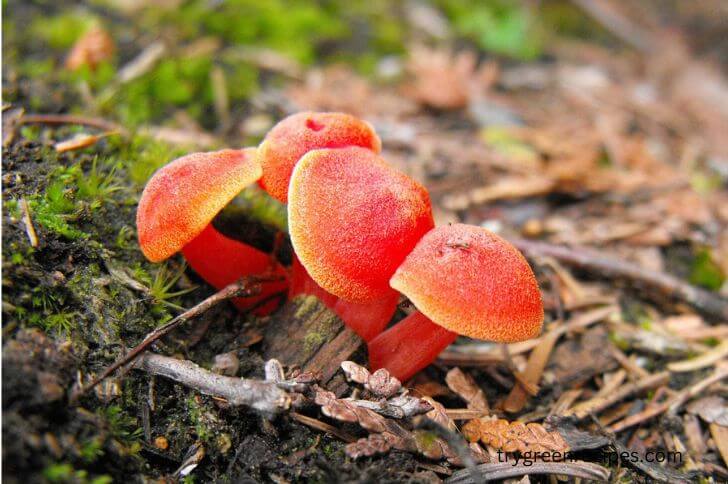
Red waxcap is a type of fungus that typically grows in grassy areas. They are found across Europe as well as North America. It is also known as the scarlet hood.
Identification:
This particular fungi is characterized by its red cap and stem. The cap measures about 2 inches when mature; starts off bell-shaped and eventually flattens when the mushroom matures. Its stipe is also red with a bright yellowish base.
On the underside you’ll notice the well-spaced red-orange gills. As the mushroom ages, they turn yellowish.
Can you eat red waxcaps? This small red mushroom is considered a delicacy in some cultures and is often used in culinary dishes. The taste has been described as bland. The best time to harvest red waxcap is during the fall months.
2. Rosy Russula
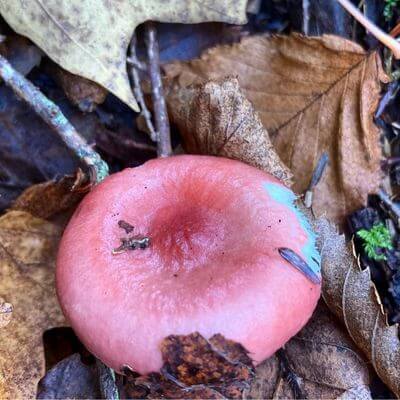
Russula mushroom species come in different colors. Russula rosea or Rosy brittlegill are wild mushrooms that belong to this family and this is how to identify them.
Identification:
Typically found in woods from August to October, these edible mushrooms were first described in the late 1700s. Like the waxcap above they have red caps which are about 5 inches wide. Young mushrooms have convex-shaped caps which flattens as the mushroom matures.
Underneath you’ll notice the pinkish gills that break easily. Its stalk is about 4 inches long. Is this mushroom edible? Its white flesh is edible. But we recommend that if you are not familiar with these red mushrooms, then avoid this species.
3. Cinnabar Chanterelle
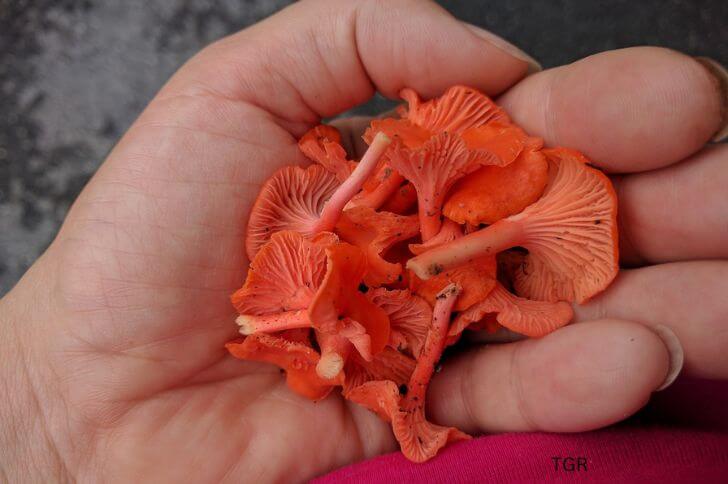
Loved for its vivid bright red-orange color, Cinnabar Red Chanterelle is a species of edible mushroom in the Cantharellaceae family.
Identification:
This particular chanterelle is found in North America, specifically in the eastern side of the United States.
The Cinnabar Red Chanterelle has a distinct coloration that ranges from red to orange to flamingo pink. It also has a slightly fruity smell.
This mushroom can be found growing on the ground in hardwood forests near oak trees. Are these red mushrooms edible? Yes, cinnabar-red chanterelles are edible.
They are highly prized by chefs and home cooks alike due to their unique flavor and color. When cooked, this mushroom imparts a slightly sweet flavor. The vibrant red color of the Cinnabar Red Chanterelle also makes it an attractive addition to any dish.
4. Red and Yellow Bolete Mushroom (Baorangia bicolor)
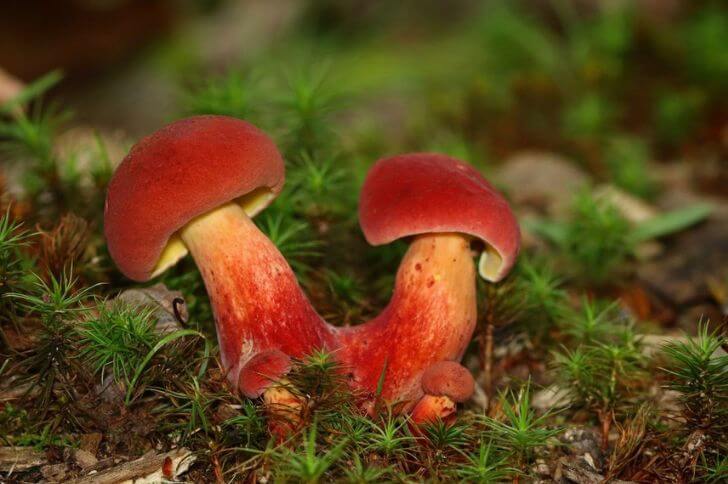
Two-colored bolete or Baorangia bicolor or the red and yellow bolete is another edible red fungus of Eastern United States. It shares the same characteristics with other members of the boletaceae family.
Identification:
It gets its name from its colors; red and yellow. The brick red cap measures about 2 inches for young shrooms and 5.9 inches when fully mature. Underneath you will notice the bright yellow spores.
Its stipe is a mix of red and yellow and measures about 3.9 inches. When cut, the flesh is yellowish flesh that smells like curry.
Red and yellow bolete mushrooms are edible, but are not as tasty as the red chanterelles above. They can be used in recipes that require mushrooms.
Related Read: Learn about orange mushrooms
5. Ox Tongue (Fistulina Hepatica)
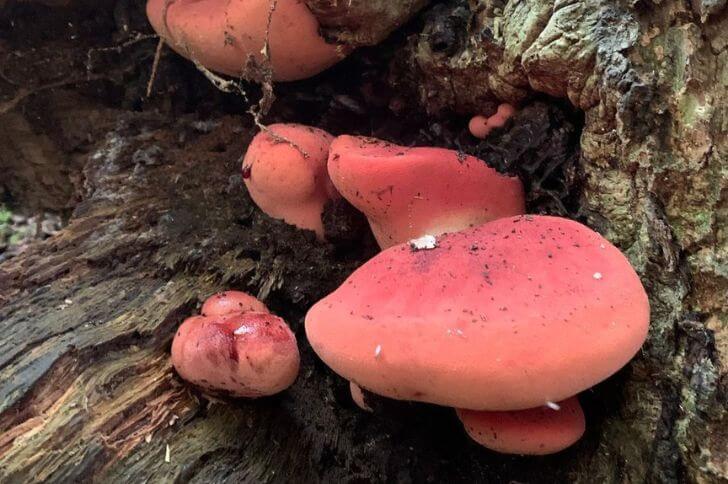
I think this is one of those mushrooms with a lot of names. But, let’s learn about it. Fistulina hepatica, poor man’s steak, beefsteak fungus, beefsteak polypore, tongue mushroom and ox tongue. Got that? Now to the identification.
Identification:
It is a bracket fungus in the family Fistulinaceae. It is characterized by its large, brown to reddish-brown fruit bodies. The cap ranges from 2.8-12 inches and about 2.4 inches thick when fully grown.
When cut, flesh has a reddish color, similar to beef steak. Now the most important question; can you eat the ox tongue mushroom? Yes, but honestly not many people want to go through the hustle of cooking it. It takes too long to cook even when young.
This fungus is found throughout parts of the US and Europe, mostly from June to October. F. hepatica has a close relationship with its host trees, and has been shown to improve the growth of some species of trees.
The taste of Fistulina hepatica has been described as bitter and sour, making it an unpopular choice.
6. Scarlet Waxy Cap
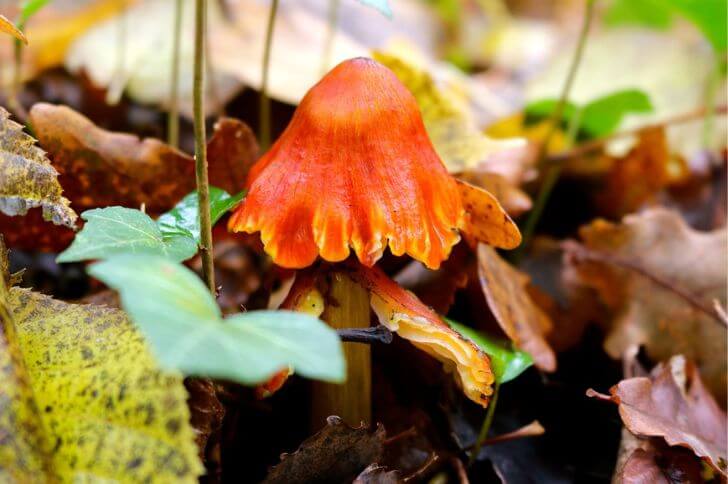
Righteous red waxy cap or scarlet hood or the scarlet waxy cap is a beautiful red mushroom species that is native to North America.
Identification:
This mushroom gets its name from its scarlet red cap, which is covered in a waxy substance. The Scarlet Waxy Cap is a member of the genus Hygrocybe, and is closely related to other waxy caps such as the Red-Staining Waxy Cap.
They are small red mushrooms with the cap measuring about 2 inches in diameter and the stalk 2 inches high.
This mushroom can be found growing on grasslands, and usually fruits from late summer to early fall. The Scarlet Waxy Cap is edible, but should be cooked before eating. However, if found that most foragers ignore it.
7. Starfish Fungus
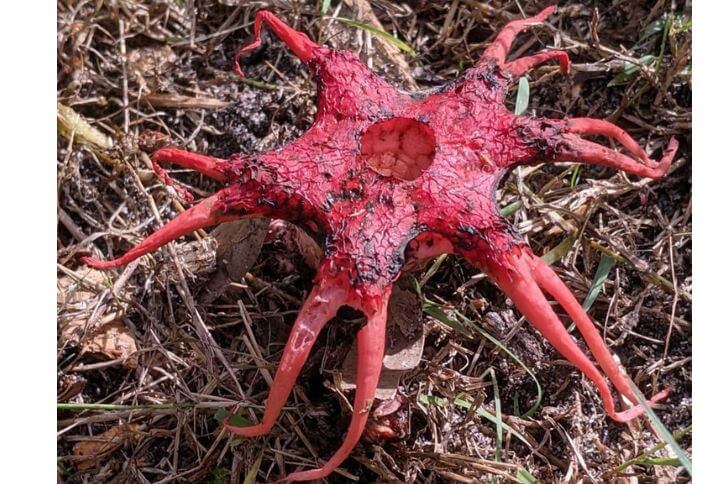
Stinkhorn mushrooms are a group of smelly fungi that often grow in gardens and lawns. They get their name from their strong odor, which is often compared to rotting flesh.
Identification:
The starfish fungus is a member of the stinkhorns family. I find it quite interesting. In the initial stage of its life cycle it looks like an egg; pale brown in color. Within a few weeks it bursts from the egg, revealing a pinkish stem with short reddish arms.
As this red fungus ages, the arms become longer and the color deepens to red. You can find them in summer and early autumn. Are stinkhorns edible? Yup, but the rotting flesh smell is unpleasant, putting off most people.
Also, they can be a nuisance if they keep popping up in your yard. If you spot a starfish mushroom, the best way to remove it is to carefully dig it up with a shovel.
You can also try to spray it with water or vinegar, but this won’t always work. The best way to prevent stinkhorns from growing in your yard is to keep your grass trimmed and tidy.
8. Red cracking bolete
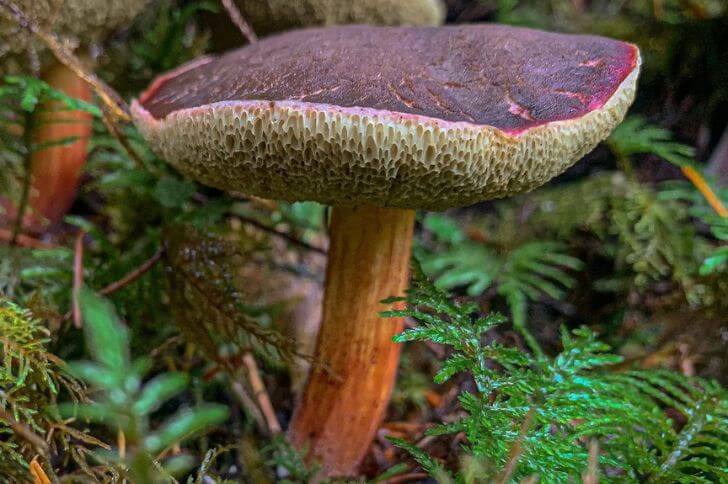
Red cracking bolete mushrooms are a type of fungi that is available from July through October. The scientific name for this mushroom is Xerocomellus chrysenteron, and it is a member of the Boletaceae family. Its pretty common in temperate zones.
Identification:
The red cracking bolete has a very distinctive appearance. The cap is typically red or reddish-brown, and it has a smooth surface. Note the yellow spores underneath. The stem is yellowish with red fibers. These mushrooms typically grow to be about 4 inches tall.
Mushroom gets its name because the cap often cracks to reveal the reddish flesh.
9. Vermilion waxcap
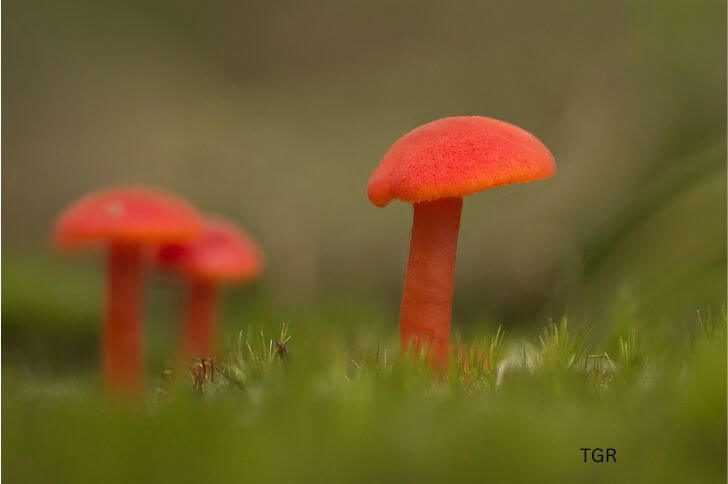
Vermilion waxcap mushrooms are a type of fungi that typically grow in grassy areas. Their fruiting body is small and are mostly found in small clusters.
Identification:
They are characterized by their bright red convex caps with orange edges. Turned, you’ll notice the gills are broadly spaced and are reddish-brown. Stalks are also dark red. When can you find vermilion waxcap? From September to November.
Can you eat this reddish orange mushroom? Scientists haven’t come to a consensus about this waxcap. So we recommend you avoid it for now.
10. Crab Brittlegill
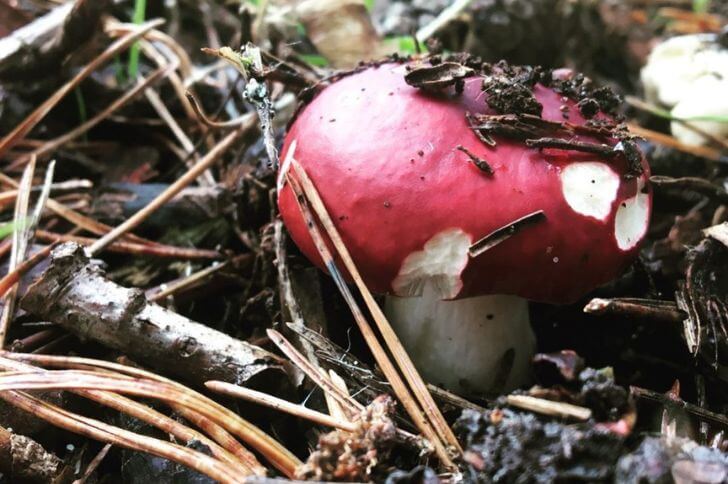
Russulas vary in color, shape and size. One of the most sought after members of this family is the Russula xerampelina. It is also known as the shrimp mushroom or crab brittlegill.
Identification:
Like most red mushroom species it favors coniferous forests of North America and Europe. It stands at 4.5 inches when fully mature with a 6-8 inches dome-shaped cap. Underneath the cream gills are well spaced compared to most species.
Can you eat shrimp mushroom? Yes, it has a shellfish odor when cooking. What I like about it is its crunchiness no matter the preparation method. Tastes like seafood too. So if you come across this species, you are in for a treat.
11. Darkening Brittlegill
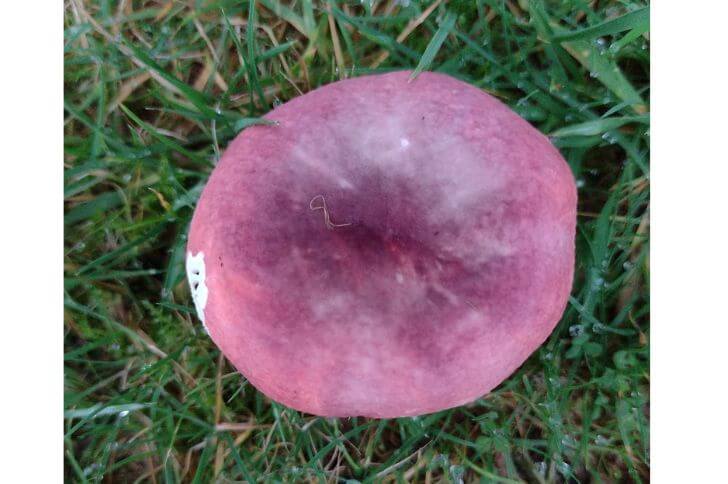
Another member of the russula family is the darkening brittlegill or russula vinosa. You can find them in summer and early weeks of Autumn.
Identification:
Like other russulas they have wide caps. However, notice that instead of the traditional dome shape, these red mushrooms have a concave shaped cap. Their color ranges from wine-red to brownish-red as they age. Note the creamish, widely-spaced gills and white stalk. They are edible.
12. Scarlet Elfcup
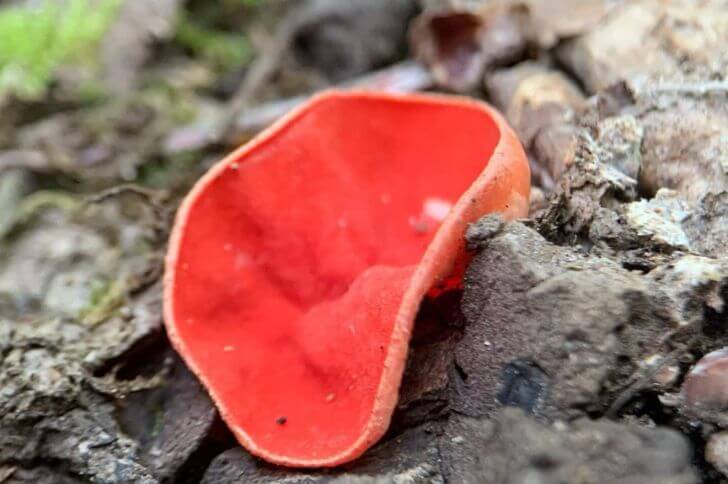
Scarlet elfcups are a species of fungus in the family Sarcosomataceae. Their scientific name is Sarcoscypha austriaca and they are also known as pézize écarlate.
Identification:
This brightly colored fungus is found growing around dead hardwood. What makes them unique is their cup-shaped cap. It’s shiny and when cut reveals whitish flesh. In some countries this species is edible, but not considered to be very tasty, while in others it’s classified as inedible.
Inedible Mushrooms that are Red
13. Blood Red Webcap (Cortinarius Sanguineus)
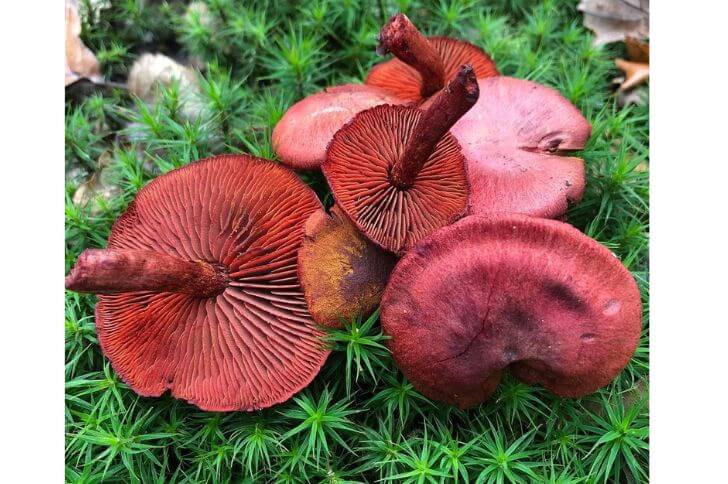
Cortinarius sanguineus, also known as the blood red webcap, is a species of fungi in the genus Cortinarius. It is a widely distributed species found in Europe.
Identification:
The fruit body of blood red webcap is a medium to large sized mushroom that typically has a dark red cap with a diameter of up to three inches. Note the cap is rough. Turn the mushroom and you’ll notice the widely spaced gills that turn red-brown as the mushroom ages.
Its stipe is also similar in color and grows to 3.14 inches tall. This red mushroom grows in tight clusters.
Are blood red webcaps edible? No.
14. Podostroma cornu-damae
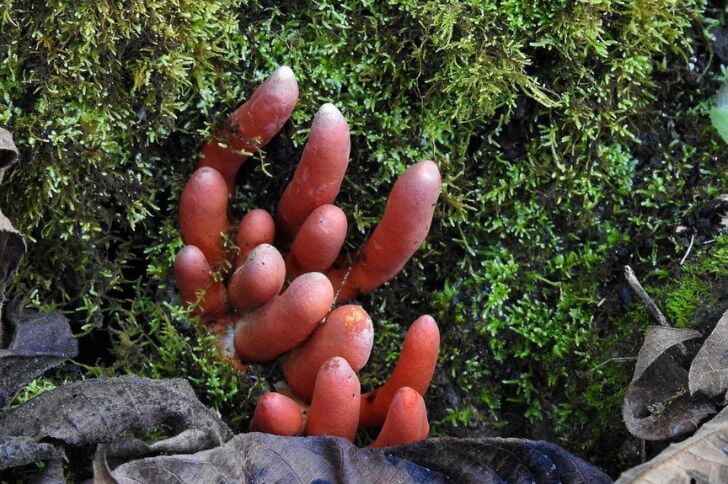
Podostroma cornu-damae, also known as the poison fire coral, is a parasitic fungus that is mostly found in Japan and Korea.
Identification:
I think it’s one of the most weird-looking mushrooms on this list. It doesn’t look like your typical mushroom. The fungus gets its name from its antler-like fruiting bodies, which can grow a few inches off the ground.
Are poison fire coral edible? No. Also, if you find them when foraging for other mushrooms, do not touch them.
15. Fly Amanita
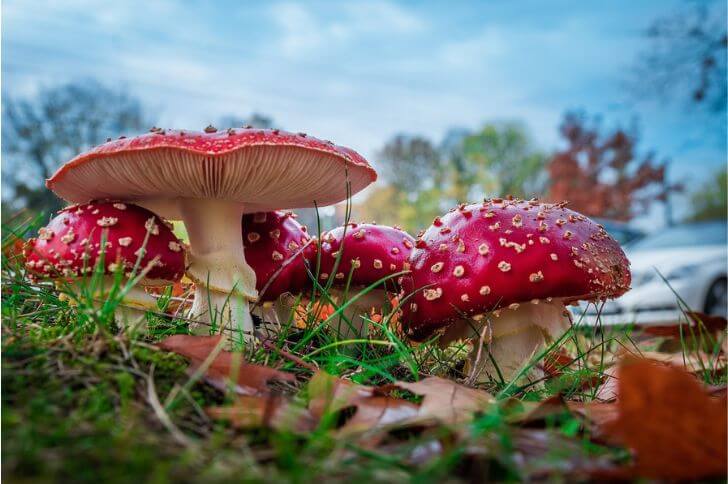
The fly amanita is a species of fungus that gets its name from its use as a pesticide- farmers would put it out in bowls to attract and kill flies.. It is also called the fly agaric or Amanita muscaria.
Identification:
This type of fungus is found all over the world and typically grows in wooded areas. It has a distinctive bright red cap with noticeable white spots. In its early stages, this shroom sports a convex cap that flattens as it ages and may have a slight concave shape when mature.
If you come across it, do not touch it. It’s inedible.
16. Pycnoporus sanguineus
Nestled within the lush forests, the Pycnoporus sanguineus emerges as a striking symbol of vitality and intrigue. Its orange-red hue exudes a sense of mystery, drawing curious onlookers into its captivating presence.
As nature’s proficient recycler, this mushroom plays an essential role in decomposing plant matter, enriching the soil with its potent enzymes and organic materials.
17. Stropharia Rugosoannulata (Garden Giant)
Stropharia rugosoannulata, commonly known as the wine cap mushroom, is a fascinating species that has been gaining attention for its potential environmental benefits.
This striking red-capped fungus is not only visually appealing but also plays a crucial role in supporting healthy soil ecosystems. Its mycelium helps to break down organic matter, improving soil structure and fertility.
This unique ability makes it a valuable ally for gardeners and farmers looking to enhance their soil quality in a natural and sustainable way.
Another intriguing aspect of Stropharia rugosoannulata is its use in permaculture practices. As a pioneer species, it can be cultivated to accelerate the process of creating fertile soil in degraded or barren areas.
By introducing this mushroom into barren landscapes, it can kickstart the decomposition of woody debris and other organic materials, ultimately paving the way for the establishment of diverse plant communities.
This highlights how red mushrooms like Stropharia rugosoannulata are not only visually striking but also essential contributors to ecological restoration efforts and sustainable land management practices.
18. Russula Emetica (Sickener fungus)
The Russula emetica, more commonly known as the sickener mushroom, is a striking red fungus that may captivate forager’s attention due to its vibrant color.
However, this visually appealing mushroom holds a sinister secret – it is extremely toxic. Despite its toxicity, some intriguing research has suggested potential medicinal properties within its compounds that warrant further investigation.
The contrasting duality of beauty and danger embodied by the Russula emetica serves as a potent reminder of nature’s complexity and the importance of exercising caution when engaging with wild mushrooms.
19. Butyriboletus Frostii (Frost Bolete)
Butyriboletus frostii, also known as Frost’s bolete (other name apple bolete) is a strikingly beautiful red mushroom that captivates mushroom enthusiasts with its unique appearance and potential culinary uses.
This species is characterized by its vibrant red cap, which develops a slightly sticky texture when dampened. Its red pores underneath the cap release a faint but pleasant odor reminiscent of buttered corn.
Butyriboletus frostii has been found in various hardwood forests across North America, particularly in association with oak and beech trees, making it an exciting find for foragers and researchers alike.
Despite its alluring aesthetics, Butyriboletus frostii presents a challenging puzzle for mycologists due to its elusive nature and complex taxonomy. Understanding the ecological role of this enigmatic fungus remains an area of active research, as scientists seek to unravel its interactions with other organisms within the forest ecosystem.
Additionally, while some culinary enthusiasts have reported enjoying Butyriboletus frostii as a delectable edible mushroom, caution is advised due to potential confusion with toxic lookalike species.
20. Clathrus Archeri (Octopus Stinkhorn)
The Clathrus archeri, also known as the octopus stinkhorn or devil’s fingers, is a fascinating and intriguing species of fungus that has captured the attention of both scientists and nature enthusiasts.
This unique mushroom is recognizable for its otherworldly appearance, with bright red tentacle-like arms emerging from a gelatinous egg-like structure. What sets this species apart is its remarkable method of reproduction – it releases a foul odor akin to rotting flesh to attract flies and insects, which then aid in dispersing its spore-laden slime.
In addition to its visually striking characteristics, the Clathrus archeri’s life cycle offers insight into the complex relationship between fungi and their ecological surroundings.
FAQs
What are red mushrooms in the yard?
Red mushrooms growing in yards can be a cause for concern for some homeowners. Common red mushrooms in the yard include the fly agaric. These mushrooms are often associated with decay and death, and their appearance in yards can be unsettling. However, they are not always indicative of a problem. In fact, they can sometimes be helpful to the ecosystem.
Can you eat red capped mushrooms?
Red capped mushrooms are a type of fungi that can be found in many different environments. You need to be able to identify red edible mushrooms from non-edible species.
Edible capped mushrooms include Red Waxcap, Red and Yellow Bolete Mushroom, and Cinnabar-Red Chanterelle.
What do you do with red mushrooms?
Red mushrooms are a type of fungi that can be found in many different biomes. While some can be cooked, their main use is as a source of red dye.
Once you have collected some red mushrooms, you can either use them immediately or keep them for later. If you plan on using them for dye, it is best to grind them up into a powder first. This powder can then be used to create a variety of different colors of dye.
Can you eat red mushrooms with white spots?
If you are foraging for mushrooms and come across a red mushroom that you cannot identify accurately, it is best to leave it alone. Most mushrooms with white spots belong to the amanitaceae family, making them unsafe for consumption.
| Name | Scientific Name | Size | Edibility |
| Red Waxy Cap | Hygrocybe coccinea | 2 inches | Choice edible |
| Rosy Russula | Russula rosea | 3.9 inches | Edible |
| Cinnabar Chanterelle | Cantharellus cinnabarinus | 1.5 inches | Edible |
| Red and Yellow Bolete | Baorangia bicolor | 5.9 inches | Choice Edible |
| Ox Tongue | Fistulina hepatica | 11.8 inches | Edible |
| Scarlet Waxy Cap | Hygrocybe punicea | 3 inches | Inedible |
| Starfish Fungus | Aseroe rubra | 1.2 inches | Inedible |
| Red cracking bolete | Xerocomellus chrysenteron | 3.7 inches | Edible |
| Vermilion waxcap | Hygrocybe miniata | 1.3 inches | Unknown |
| Crab Brittlegill | Russula xerampelina | 8 inches | Choice |
| Darkening Brittlegill | Russula vinosa | 5.9 inches | Edible |
| Scarlet Elfcup | Sarcoscypha coccinea | 2.4 | Edible |
| Blood Red Webcap | Cortinarius sanguineus | 2 inches | Inedible |
| Poison fire coral | Podostroma cornu-damae | Inedible | |
| Fly Amanita | Amanita muscaria | 8 inches | Inedible |
| Pycnoporus sanguineus | Pycnoporus sanguineus | Inedible | |
| Garden Giant | Stropharia Rugosoannulata | 8 inches | Choice |
| The sickener | Russula Emetica | 3.3 inches | Inedible |
| Frost’s bolete | Butyriboletus Frostii | 5.9 inches | Edible |
| Octopus Stinkhorn | Clathrus Archeri | 6 inches | Inedible |
Sources:
Hi There,
My name is Jenny. I’m the Chief Editor at Try Green Recipes and besides making yummy and healthy foods for my kids, grandkids, and friends. I’m new to the blogging world but I believe what I have to share is unique and will bring joy to your home. If you are adventurous and want try something tasty, let’s get started.

